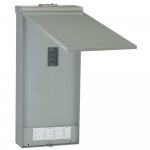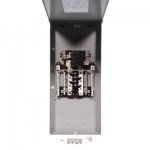https://www.eaton.com/us/en-us/compa...rotection.html
“Safety disconnect (formerly the firefighter disconnect)
The 2020 change
Language now exists in Article 230.85 for emergency disconnects on the exterior of one- and two-family dwelling units so that first responders may quickly disconnect power to a structure. Language in Article 445.18 also addresses emergency generator shutdown.
The rationale for change
Aside from fire dangers, first responders often must account for electrical hazards during emergencies. Fires are chaotic, with firefighters rushing to ventilate buildings on rooftops, breaking through windows and opening walls in seconds. With that, there’s a real danger of coming in contact with energized conductors and equipment.
Typically, first responders look to turn the power off before entering a blaze, but many homes’ panelboards are in basements. Terminating power at the transformer, which could be atop a pole, is not something any untrained person should attempt. This change mandates placing emergency disconnects near the service entrance equipment outside of a structure.
What might the future hold?
Concerns were raised during requirement debates that safety disconnects allow anyone to terminate the power to a home. The NEC’s response was to allow the installation of disconnect locks to thwart unauthorized power access. While the locks will not impede firefighters or other first responders and may provide a level of comfort to the homeowner, contractors will still have to explain the expense of safety disconnects, especially in locations where it’s not common practice to add outdoor service panelboards. When bidding on new jobs, technicians should stress the importance of safety to justify costs to consumers. “
It makes sense to a point... somewhere someone had a busted bulb in their crawl space and got into the bare filaments receiving a shock. Now a crawl space lighting is GFCI...
its been discussed here before...
https://forums.mikeholt.com/forum/a...er-disco-1-2-family-dwellings-230-85?t=193366



![URL]](http://[URL]https://i.ebayimg.com/images/g/ugcAAOSwmIJZeMgn/s-l1600.jpg[/URL])
![URL]](http://[URL]https://www.picclickimg.com/d/l400/pict/192467108716_/Zinsco-100-amp-Circuit-Breaker-Main-Disconnect-Meter.jpg[/URL])